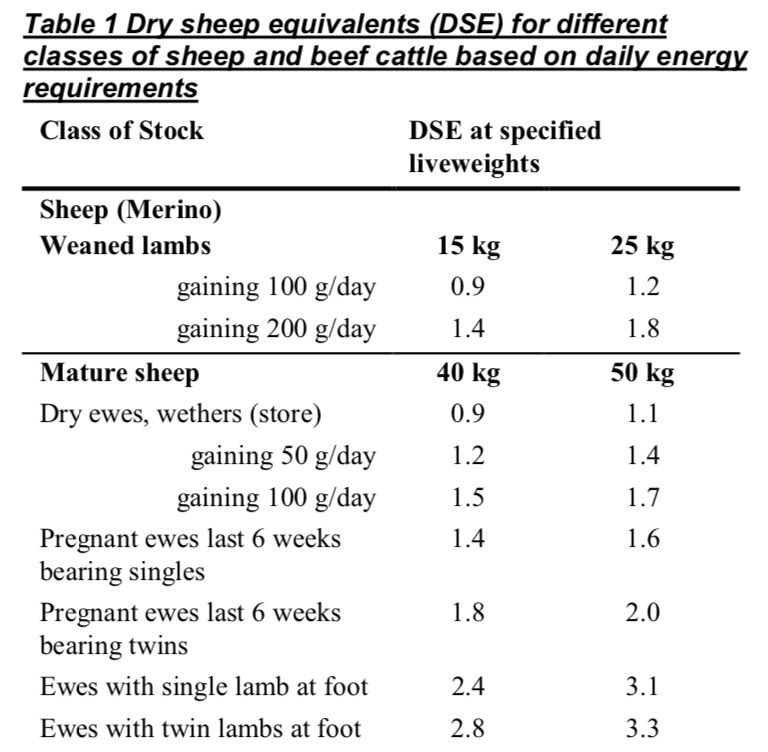DSE - rubbery at best?
- Wayne
- Sep 3, 2019
- 3 min read
I get asked frequently about what DSE we are at and what DSE I am aiming to be at. For those not familiar with "DSE", it stands for Dry Sheep Equivalent. A "dry" sheep is a ewe that is not pregnant. 1 DSE is a 45kg dry ewe or a wether that is not growing but is maintaining its weight.
When I try to give an answer, it is a rubbery figure. This is because the DSE of any sheep changes daily. If they are gaining weight, their DSE rating is higher. If they are pregnant, or have a small lamb or a big lamb feeding off her, the DSE is much higher. The bigger the ewe is, the bigger her DSE rating (ie the more energy she needs to eat).
In the table below of the various DSE ratings, you can see the numbers vary substantially. These are all based on the energy the sheep needs to consume to maintain the weight, or maintain the growth per day etc.

If you have a 70kg ewe with twin lambs at foot, her rating is closer to 4.
Anyway, my point is that I can't give anyone an accurate DSE figure of where we are at today. I can make an estimate, but it won't be accurate because I have not weighed every sheep that day, and I have no idea of what rate they are gaining or losing weight on that day.
One consultant has a simple rule of thumb for operations like ours where we have ewes, lambs at foot, ewes in lamb, weaners, and some rams. He uses a DSE average of "2" per adult sheep. I tried that with our situation and it is within 30% from what I come up with after 10 minutes of lots of calculations, so it is a lot quicker, but is less accurate.
When we know what pasture growth can happen, and we combine that with what we know how much pasture 1 DSE needs to eat to maintain weight, we can come up with a "potential" DSE for your farm. For our Narrikup farm on ~700mm annual rainfall, our potential is ~58 DSE/ha/year. However, it is actually higher than that because the formula from CSBP (a fertiliser company who has done decades of pasture research), only assumes the pasture is a clover/medic and ryegrass pasture.
Ryegrass is a C3 grass, but our pasture has a base of kikuyu, a C4 grass. C4 grasses produce significantly more biomass per mm rain than a C3 grass, and being a summer active grass, it does use summer rain whereas the winter active ryegrass and clover aren't even growing in summer to use the rain. So I think our actual potential is ~70 DSE/ha.
But, we don't live in a perfect world and things always go wrong in agriculture, however, it is a target I am aiming at with fervour. In my day to day thinking, I am not aiming to be at a DSE by a certain date, but I am aiming to carry as many sheep as the farm allows and as quickly as I can. I have a target of 30 ewes/ha by next year producing 45 lambs/ha, but I hope we can do more than that. We will try.
If I don't over do it, I have not tried hard enough to be as efficient as possible.
So when the new trade sheep arrive this week, my rough calculation for our average DSE across the whole farm is >55 DSE/ha, but that assumes things like the trade sheep and weaners are growing at 200g/day (many should be doing more than that), and the rams and old ewes are maintaining their weight. The calculation will change every time we sell and buy in new sheep. After the trade sheep are all gone, we should be back around 30 DSE/ha as we will have also sold many more lambs and culled rams and ewes.
DSE ratings are rubbery, very rubbery, and are only useful as a guide to me. Down the track, I will be far more interested in knowing how many kgs/ha of meat we sold and at what profit and cost, but I also hope we are getting close to the theoretical potential DSE/ha/year.
kaizen = constant improvement.



Best explanation of DSE I have read for a while. Well done Wayne and Caluka team. Pasture and lambs look fantastic